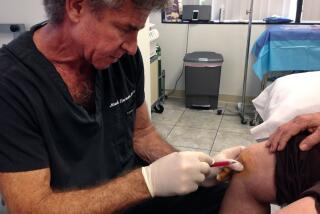New Westlake Facility Offers Sophisticated Cancer Procedure : Medicine: Bone Marrow and Blood Stem Cell Transplant Center is the first in area to provide the service.
- Share via
At Westlake Comprehensive Cancer Center, deep in a freezer filled with liquid nitrogen, blood cells from cancer patient Guadalupe Govea lie frozen, waiting to give the 39-year-old Moorpark woman another chance at life.
Soon Govea will endure a dose of chemotherapy so strong it will kill her bone marrow and, doctors hope, any cancers lurking in her body.
Then those frozen “stem” cells--those that produce bone marrow--will be thawed and restored to her system.
Govea is one of the first patients to use the new Bone Marrow and Blood Stem Cell Transplant Center at Westlake Medical Center, which straddles the Ventura County line and is the first local hospital to provide this service.
Opened in June, the transplant center hopes to draw patients from this county who would otherwise have had to go to Los Angeles to receive the sophisticated treatment. It is headed by Dr. Robert Peter Gale, a pioneer in bone marrow transplants for his work with victims of the Chernobyl disaster, and Dr. Maurice Wolin.
“I’m happy to be going there,” Govea said. “This way I don’t have to drive the whole way to UCLA.”
The procedure is expensive, she said, and it took some persuasion to get her insurance company to cover the $50,000 to $200,000 cost.
Three years ago Govea was found to have breast cancer. Chemotherapy sent her cancer into remission, but the disease returned this spring. In late June she had both breasts removed, and her doctor advised her to follow that surgery with the high-dose chemotherapy and stem cell transplant.
“My doctor told me if I get another cancer anywhere else in my body there would be nothing that they could do,” the mother of three said. “From what I understand, after this I won’t have cancer at all.”
As Wolin explains it, the process Govea is going through is surprisingly simple. Typically, marrow is removed from a patient’s bones through a surgical procedure involving many painful encounters with long needles.
But a new procedure is coming into vogue. Wolin said doctors have known for 30 years that stem cells, the cells that produce bone marrow, are present in the blood stream in small quantities.
About five years ago, doctors discovered a way to increase those numbers with drugs, then essentially extract them from a patient. A machine pumps the patient’s blood through a centrifuge, which spins out the stem cells.
Gathering enough cells to replace the dead bone marrow takes several four-hour sessions at the centrifuge machine. The cells are frozen, setting the stage for intense chemotherapy treatment.
About a week after the patient goes through the chemotherapy sessions--radiation doses 10 times the usual--the stored stem cells are returned and the bone marrow begins to grow back.
A bone marrow transplant for cancers other than leukemia, where the actual marrow is diseased, is still somewhat controversial--mostly because insurance companies are reluctant to pay for the expensive procedure unless it is absolutely necessary, Wolin said.
“The controversy isn’t over whether this procedure works or not,” Wolin said. “It’s the insurance companies drawing a line in the sand, saying if we pay for every woman with breast cancer to have a transplant we are going to go bankrupt.”
Still, stem cell transplants are becoming more common in treatment of a variety of cancers, he said. “I’m convinced that it will replace the old methods,” Wolin said.
Wolin said Westlake also hopes to begin doing bone marrow transplants using donors within a year. As a specialist in leukemia, he said he is eager to try stem cell transplants from one person to another.
That treatment is also controversial because the type of cells that cause a common complication in transplants called “graft versus host disease” are present in high numbers in stem-cell collections, he said.
In transplants from one person to another, chances of infection are greatly increased. Many patients need to be kept in sealed environments to ward off infections. Wolin said Westlake plans to build such a “bubble room” within a year.
The hospital expects to do about 25 transplants this year and 50 next year, he said.
Westlake has drawn criticism from some local hospitals for investing $10 million in its highly specialized cancer treatment center for which there is not much local demand.
Nancy La Sota, director of Los Robles Regional Medical Center’s CancerCare facility, said she sends patients who need bone marrow transplants to UCLA, which is affiliated with Los Robles.
“We feel the technology is not cost-effective to have out in the community,” she said.
But Wolin said he sees a need for a transplant center for cancer patients in Ventura, Santa Barbara and northern Los Angeles counties. Traveling to Los Angeles for the treatment puts a strain on many patients, he said, particularly those who have to make frequent trips for checkups.
More to Read
Sign up for Essential California
The most important California stories and recommendations in your inbox every morning.
You may occasionally receive promotional content from the Los Angeles Times.












